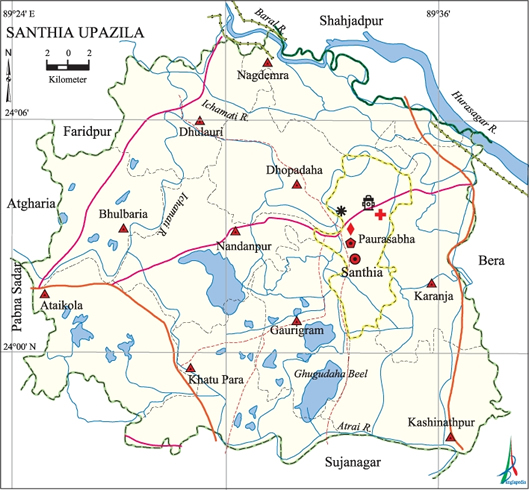Santhia Upazila
Santhia Upazila (pabna district) area 331.56 sq km, located in between 23°57' and 24°08' north latitudes and in between 89°25' and 89°37' east longitudes. It is bounded by faridpur (pabna) and shahjadpur upazilas on the north, sujanagar upazila on the south, bera upazila on the east, atgharia and pabna sadar upazilas on the west.
Population Total 323932; male 168599, female 155333; Muslim 313656, Hindu 10125, Buddhist 123 and others 28.
Water bodies Main rivers: ichamati, baral, atrai; Ghugudaha Beel is notable.
Administration Santhia Thana was formed in 1905 and it was turned into an upazila in 1986.
| Upazila | ||||||||
| Municipality | Union | Mouza | Village | Population | Density (per sq km) | Literacy rate (%) | ||
| Urban | Rural | Urban | Rural | |||||
| 1 | 10 | 177 | 232 | 41711 | 282221 | 977 | 44.1 | 37.4 |
| Municipality | ||||||||
| Area (sq km) | Ward | Mahalla | Population | Density (per sq km) | Literacy rate (%) | |||
| 25.41 | 9 | 26 | 33374 | 1313 | 43.3 | |||
| Upazila Town | ||||||||
| Area (sq km) | Mouza | Population | Density (per sq km) | Literacy rate (%) | ||||
| 2.54 | 1 | 8337 | 3282 | 47.5 | ||||
| Union | ||||||||
| Name of union and GO code | Area (acre) | Population | Literacy rate (%) | |||||
| Male | Female | |||||||
| Ataikola 15 | 8790 | 16021 | 13817 | 44.16 | ||||
| Karanja 51 | 7982 | 17867 | 16288 | 44.00 | ||||
| Kashinathpur 60 | 8958 | 19672 | 18281 | 38.39 | ||||
| Khatu Para 69 | 7655 | 15746 | 14728 | 33.35 | ||||
| Gaurigram 43 | 7164 | 10593 | 9778 | 34.06 | ||||
| Dhopadaha 25 | 6550 | 12689 | 12039 | 33.85 | ||||
| Dhulauri 34 | 7211 | 14387 | 13533 | 33.63 | ||||
| Nandanpur 86 | 7350 | 13845 | 12912 | 38.44 | ||||
| Nagdemra 77 | 6600 | 16526 | 15063 | 40.64 | ||||
| Bhulbaria 17 | 7566 | 13790 | 12983 | 32.33 | ||||
Source Bangladesh Population Census 2001,Bangladesh Bureau of Statistics.
Archaeological heritage and relics Ganesh Mandir (19th century)
History of the War of Liberation On 27 November 1971, the Pak army in collaboration with the local razakars violated women at Fakir Para under Dhulauri union of Santhia upazila; they also captured 22 freedom fighters and killed 21 of them on the bank of the river Ichamati by bayonet charges. Santhia upazila was liberated on 15 December.

Marks of the War of Liberation Mass grave 1 (Nagdemra); memorial monument 2 (Shahidnagar and Santhia upazila compound)
Religious institutions Mosque 360, temple 48, church 2. Noted religious institutions: Upazila Jami Mosque, Nagdemra Jami Mosque, Shahidnagar Jami Mosque, Santhia Kali Mandir, Ataikola Christan Missionaries Church.
Literacy rate and educational institutions Average literacy 38.3%; male 41.6%, female 34.7%. Educational institutions: college 9, secondary school 43, primary school 171, kindergarten 5, madrasa 52. Noted educational institutions: Miapur Haji Jasimuddin School and College (1965), Santhia Pilot High School (1943), Ataikola High School (1939), Santhia Government Primary School (1901), Nagdemra Government Primary School, Raghunathpur Government Primary School, Dhulauri Kawsaria Kamil Madrasa (1907), Boalmari Kamil Madrasa (1940).
Cultural organizations Library 4, club 16, theatre group 1, cinema hall 3, jatra party 1, playground 11, women society 6.
Main sources of income Agriculture 65.44%, non-agricultural labourer 4.72%, industry 5.52%, commerce 10.65%, transport and communication 2.87%, service 4.17%, construction 0.88%, religious service 0.10%, rent and remittance 0.20% and others 5.45%.
Ownership of agricultural land Landowner 59.08%, landless 40.92%; agricultural landowner: urban 50.25% and rural 60.39%.
Main crops Paddy, wheat, potato, onion, vegetables, mustard.
Extinct or nearly extinct crops Barley, sesame, kaun, tobacco.
Main fruits Mango, papaya, banana.
Fisheries, dairies and poultries Fishery 35, dairy 997, poultry 120, nursery (fish) 1.
Communication facilities Pucca road 140.80 km, semi-pucca road 19.78 km, mud road 471.79 km; waterway 12 nautical miles.
Extinct or nearly extinct traditional transport Palanquin, horse carriage.
Noted manufactories Rice mill, flour mill, ice factory, hosiery factory, welding factory.
Cottage industries Goldsmith, blacksmith, weaving, wood work, bamboo work, cane work.
Hats, bazars and fairs Hats and bazars are 30, fairs 3, most noted of which are Ataikola Hat, Banagram Hat, Kashinathpur Hat, Karanja Hat, Chatur Hat, Boalmari Hat, Shahidnagar Hat and Krishi Mela at Sadar Upazila.
Main exports Paddy, onion, vegetables, leather.
Access to electricity All the wards and unions of the upazila are under rural electrification net-work. However 26.83% of the dwelling households have access to electricity.
Natural resources Lime stone, sand stone, lime, coal, sand.
Sources of drinking water Tube-well 96.62%, tap 0.33%, pond 0.23% and others 2.82%.
Sanitation 17.54% (rural 16.09% and urban 27.33%) of dwelling households of the upazila use sanitary latrines and 77.41% (rural 78.74% and urban 68.42%) of dwelling households use non-sanitary latrines; 5.05% of households do not have latrine facilities.
Health centres Upazila health complex 1, health and family welfare centre 8, satellite clinic 3, clinic 1.
Natural disasters The floods of 1988 and 1998 caused heavy damage to settlements, crops and other properties of the upazila.
NGO activities Operationally important NGOs are brac, ASA. [Prabir Goswami Babu]
References Bangladesh Population Census 2001, Bangladesh Bureau of Statistics; Cultural survey report of Santhia Upazila 2007.
